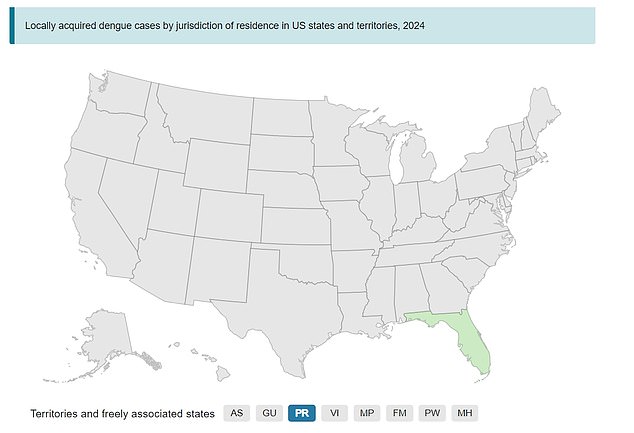Puerto Rico health officials have declared an epidemic after an alarming rise in cases of the “bone-breaking” disease.
The US territory has recorded at least 549 cases of dengue this year and more than 340 have been hospitalized.
The health department warned that this is a 140 percent increase compared to this time last year and almost half of those reported for all of 2023.
More than 40 percent of dengue cases in Puerto Rico have been concentrated in the capital of San Juan, which has almost 350,000 inhabitants.
The epidemic comes amid fierce outbreaks in South American countries such as Brazil, Peru, Paraguay and Argentina, and officials in Brazil compare it to the darkest days of Covid.
Health officials have not issued travel guides, although the increase comes amid Puerto Rico’s peak tourism season.

The latest CDC data for Puerto Rico only goes back to 2016, but health officials have announced that the territory has seen 549 cases of dengue this year.


The epidemic occurs in the middle of the high tourism season, which runs from December to April.
Epidemiologists blame rising global temperatures, which allow the virus-carrying mosquito to live longer and thrive over a wider swath of territory.
The Secretary of Health of Puerto Rico, Carlos Mellado López, wrote on We call for prevention. ‘
In 2023, the territory reported 1,293 cases of dengue, while in 2024 alone 42 percent of that figure was already recorded.
Florida has seen two cases of local transmission this year, meaning patients contracted the disease without traveling outside the country. No other states have identified cases.
Last year, the Sunshine State identified 601 travel-associated cases of dengue and 61 locally acquired cases, according to the CDC.


The map above shows the US states and territories that have reported locally acquired and travel-acquired dengue cases this year.


Florida is the only state to report dengue cases so far this year in the US, although infections are becoming more common


Dengue, nicknamed the “bone-breaking disease” for causing joint and muscle pain so severe that it feels like bones are breaking, is a virus that usually runs its course and resolves.
But in one in 20 cases it can cause bleeding and organ failure.
It usually causes a variety of flu-like symptoms, such as fever, headache, nausea, swelling and rash, for one to two weeks, but can develop into a serious and fatal infection.
Brazil has recorded more than 1.5 million cases and 390 deaths due to the disease this year alone, quickly approaching 1.6 million total confirmed cases in all of 2023.
The situation has become so serious that tents have even been erected in Brasilia and other cities at strategic points to classify patients with the virus.
Peru is experiencing a similarly large outbreak, with 32 deaths and 31,000 infections in the first two months of 2024 alone, a 97 percent increase during this same period last year.
Paraguay and Argentina have recorded more than five times the typical number of cases so far this year, with more than 150,000 and 57,000 casesrespectively.
The outbreaks in South America, which is currently experiencing the end of its summer season, could be a harbinger of what could come in the northern hemisphere.
Dengue is transmitted by infected Aedes aegypti mosquitoes, which thrive in tropical, subtropical and temperate climates.
The disease then travels to the blood cells.
Warmer temperatures during longer warm seasons mean mosquitoes can live longer, even a few days, increasing cases.
This had led experts to blame rising global temperatures for the outbreaks.
Although there are no warnings for travelers, the epidemic could also wreak havoc on Puerto Rico’s tourism industry.
In 2023, the territory recorded an all-time high in tourism revenue, reaching $9.8 billion, according to Discover Puerto Rico.
This includes more than 6.1 million passengers landing at Luis Muñoz Marín International Airport, an increase of 18.6 percent from the previous year.
The CDC has found that up to 90 percent of dengue cases in the U.S. are acquired during travel.

